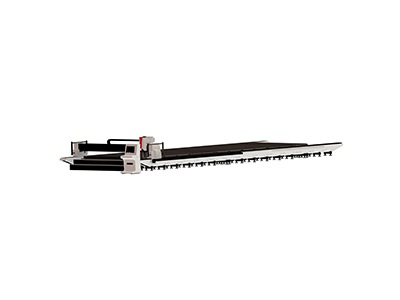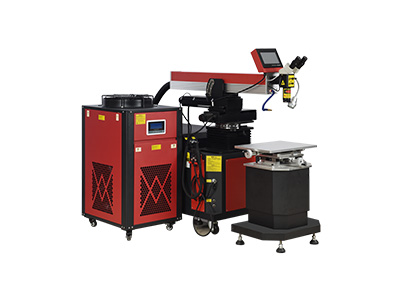- No.609, Centre Of Huijin Nanxiang, Yinxiang Road, Nanxiang Town, Jiading District, Shanghai, China
- sherry@sanmachines.com
- +86-18616767021
Laser welding machine: single wire feeding vs double wire feeding!
Laser welding technology has become a cornerstone of modern manufacturing, offering unparalleled precision, speed, and versatility. A key aspect of its operation lies in the wire feeding mechanism, which introduces filler material into the welding process to effectively join or repair components. Among the available options, normal wire feeding and twin wire feeding are two distinct methods, each of which meets specific industrial needs. Understanding their differences is important for manufacturers looking to optimize welding performance, achieve desired joint properties, and meet the needs of different applications.

This article explores the comparison between normal wire feeding and twin wire feeding in laser welding machines, clarifying their features, advantages, and limitations. Normal wire feeding is the traditional method, known for its simplicity and reliability in standard welding tasks. On the other hand, twin wire feeding represents an advanced method designed for high-performance applications, providing higher deposition rates and flexibility. By comparing these two technologies, we aim to help you find the best solution for your welding needs.
Understanding Normal Wire Feeding Laser Welding Machine
Normal wire feeding is the most common configuration of laser welding machines. In this method, a single wire is fed into the welding area as a filler material. The wire melts under the focused laser beam and fills the gap or connects the materials to form a high-quality weld.
Key Features: Conventional wire-fed laser welders use a single wire as filler material that is continuously fed into the weld zone. The system integrates a precision wire feeder with the laser beam, ensuring accurate material delivery and minimal waste. These machines are ideal for joining metals with fine tolerances where additional material is needed to fill gaps or strengthen welds. They typically support multiple diameters of welding wire and materials such as steel, aluminum, and alloys, allowing for versatility in a wide range of applications. Their straightforward design prioritizes simplicity, precision, and reliability, making them suitable for a wide range of industries.
Advantages: The main advantages of conventional wire-fed laser welders are simplicity and cost-effectiveness. They are able to provide precise material delivery, resulting in high-quality welds with minimal defects. They are relatively easy to operate and maintain, and due to the use of a single wire, have low operating costs. This makes them a practical choice for routine welding tasks where high deposition rates or advanced features are not necessary.
Limitations: Despite their reliability, conventional wire-fed laser welders face limitations in more demanding applications. Their single-wire design limits deposition rates, reducing the efficiency of welding thick or large components. They lack the flexibility to weld dissimilar materials or achieve customized metallurgical properties in the joint. In addition, they have limited applicability to advanced processes such as additive manufacturing or high-speed welding, making them less versatile than dual-wire or more advanced configurations.
Learn about Twin Wire Feed Laser Welders
Twin wire feed is an advanced configuration in laser welding that introduces two wires into the weld zone simultaneously. The system is designed to address the limitations of ordinary wire feed laser welders by increasing deposition rates, improving joint performance, and expanding the range of welding applications.
Key Features: Twin Wire Laser Welders use two wires simultaneously, which are fed into the weld zone at a controlled speed. The wires can be the same or different materials, providing versatility in joint customization and metallurgical properties. These machines are equipped with an advanced wire feeding system to ensure precise control of wire delivery, allowing for higher deposition rates. The ability to independently adjust the wire feed rate of each wire allows for customized welding strategies, making them ideal for complex tasks such as dissimilar material joining, thick workpiece welding, and additive manufacturing.
Advantages: The main advantage of the twin-wire laser welding machine is its significantly enhanced deposition rate, which increases welding efficiency and reduces processing time. They provide flexibility in material selection, allowing dissimilar metals to be welded or alloying elements added to improve joint strength, corrosion resistance or other properties. Additionally, their ability to handle thicker materials and produce high-quality welds with fewer defects enhances their appeal for demanding industrial tasks.
Limitations: Twin-wire laser welding machines, while offering advanced features, are more complex and costly. Additional wire feed systems and control mechanisms increase the initial investment and require more maintenance. Operating these machines often requires skilled personnel to manage the complex wire feeding process and optimize parameters. Additionally, the higher material consumption associated with twin-wire feed results in increased operating costs, making it less economical for small-scale or routine welding tasks. Their advanced capabilities may also be underutilized in applications where single-filament feeding is sufficient, reducing their cost-effectiveness in such situations.
Normal wire feed and double wire feed provide unique advantages for laser welding machines. Regular wire feed is ideal for general-purpose tasks, while dual wire feed excels in high-performance, demanding applications. By understanding the differences, applications, and limitations of these methods, you can make informed decisions that maximize the efficiency, quality, and cost-effectiveness of your welding operations.
SAN LASER is a well-known laser welding machine manufacturer in China, known for its innovative solutions, high-quality products and commitment to customer satisfaction. Whether you are looking for a traditional wire-fed laser welding machine or an advanced dual-wire system, we offer a range of customization options to meet the diverse needs of modern industries.
Related product links


































 Welder News
Welder News




